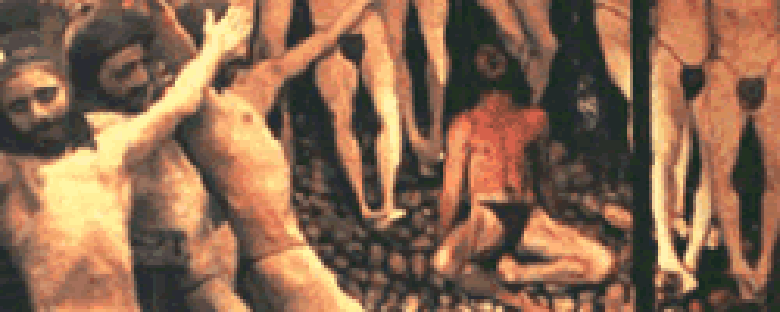Reviews
La Montaña sagrada
Alejandro Jodorowsky
Mexico, 1973
Credits
Review by Rumsey Taylor
Posted on 11 July 2004
Source RaroVideo DVD
Related articles
Features: Directors: Alejandro Jodorowsky
Reviews: El Topo
Reviews: Santa Sangre
Alejandro Jodorowsky’s The Holy Mountain was his first — and only — film spawned directly from his relationship with Beatles producer Allen Klein. The film opened two years after El Topo, and in comparison to his former film, The Holy Mountain is more ambitious, surreal, and “complete” in its every aspect. El Topo is the planet to The Holy Mountain’s universe.
As a whole, the film contains a noticeable lack of dialogue (especially in the opening third). As per usual, icons, indirect references, and allusions — some obvious, most are ambiguous — occur with meticulous frequency. For the matter, even the most incidental detail or prop relays a history of meaning.
The most easily interpretable aspect of the film is its religion. Its first portion traces a Christ figure, perhaps in a retelling of scripture. The man is worshipped, taken by a group of men who form a plaster cast of his body and reproduce the form. In a visually stirring scene, the man (credited as the Thief) awakens in a room full of models of himself.
At this point Jodorowsky’s commentary is evident: God, as man, is seen as a sort of celebrity. He is garnered with fame, his image is worshiped. It must be stated, again, that the film offers a bounty of different interpretations; this is but my own.
Christ flees his suitors, finds a slender, nondescript tower, and rides an enlarged fishing hook to the top. Inside is the Alchemist (Jodorowsky himself, as God?). He speaks of the holy mountain, a location that will provide ultimate truth and immortality.
The Alchemist mentors the Thief. He assembles a team of disciples, each of which is from a different planet. The religion that dominates the opening of the film is displaced hereon by Jodorowsky’s social commentary.
Each disciple is involved in some outrageous occupation on his home planet. Here, the director’s opinions are made on most every societal practice: aside from religion, sexual roles, jurisdiction, monetary wealth, sex, and, given the abundance of the film’s iconography, many, many others.
The Holy Mountain branches endlessly into different thematic directions. For this reason, I find it futile (and limiting) to relay more of the film — most any critique of the film would direct a certain precognition. The Holy Mountain — at the very least — is a film vast in its applications; each subjective interpretation likely differs from the next.
Viscerally the film is a masterwork. Like no other Jodorowsky understands the power of the image. Though it can be justified that many of these images are employed solely to shock, they are powerful images nonetheless. The late glimpse of a man holding excised leopard heads to his breast (milk shoots out of one), for one, is bound to elicit some response from any viewer.
We don’t do comments anymore, but you may contact us here or find us on Twitter or Facebook.



